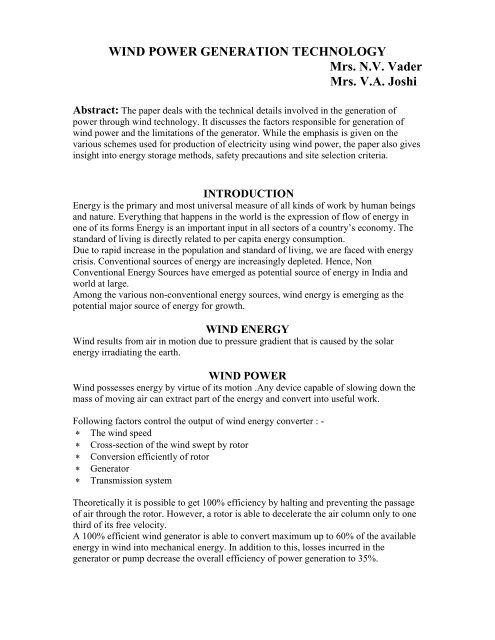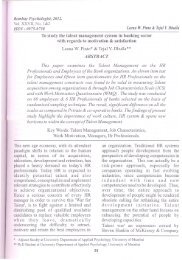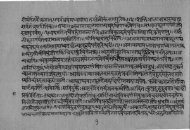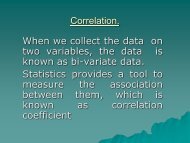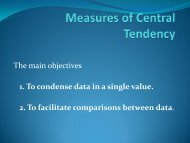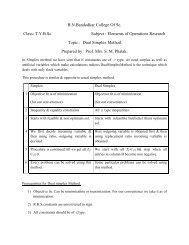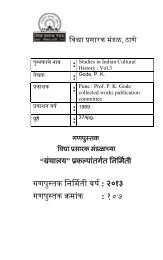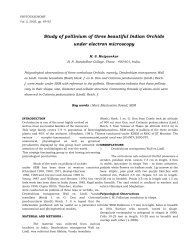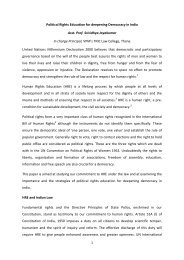WIND POWER GENERATION TECHNOLOGY.pdf
WIND POWER GENERATION TECHNOLOGY.pdf
WIND POWER GENERATION TECHNOLOGY.pdf
Create successful ePaper yourself
Turn your PDF publications into a flip-book with our unique Google optimized e-Paper software.
<strong>WIND</strong> <strong>POWER</strong> <strong>GENERATION</strong> <strong>TECHNOLOGY</strong>Mrs. N.V. VaderMrs. V.A. JoshiAbstract: The paper deals with the technical details involved in the generation ofpower through wind technology. It discusses the factors responsible for generation ofwind power and the limitations of the generator. While the emphasis is given on thevarious schemes used for production of electricity using wind power, the paper also givesinsight into energy storage methods, safety precautions and site selection criteria.INTRODUCTIONEnergy is the primary and most universal measure of all kinds of work by human beingsand nature. Everything that happens in the world is the expression of flow of energy inone of its forms Energy is an important input in all sectors of a country’s economy. Thestandard of living is directly related to per capita energy consumption.Due to rapid increase in the population and standard of living, we are faced with energycrisis. Conventional sources of energy are increasingly depleted. Hence, NonConventional Energy Sources have emerged as potential source of energy in India andworld at large.Among the various non-conventional energy sources, wind energy is emerging as thepotential major source of energy for growth.<strong>WIND</strong> ENERGYWind results from air in motion due to pressure gradient that is caused by the solarenergy irradiating the earth.<strong>WIND</strong> <strong>POWER</strong>Wind possesses energy by virtue of its motion .Any device capable of slowing down themass of moving air can extract part of the energy and convert into useful work.Following factors control the output of wind energy converter : - The wind speed Cross-section of the wind swept by rotor Conversion efficiently of rotor Generator Transmission systemTheoretically it is possible to get 100% efficiency by halting and preventing the passageof air through the rotor. However, a rotor is able to decelerate the air column only to onethird of its free velocity.A 100% efficient wind generator is able to convert maximum up to 60% of the availableenergy in wind into mechanical energy. In addition to this, losses incurred in thegenerator or pump decrease the overall efficiency of power generation to 35%.
PRINCIPLE OF ENERGY CONVERSIONWind mills or turbines works on the principle of converting kinetic energy of the windin to mechanical energy.Power available from wind mill}= ½ A V³Where, – air density = 1.225 Kg. / m³ at sea level.(changes by 10-15% due totemperature and pressure variations)A – area swept by windmill rotor = D² sq-m. (D – diameter )V – wind speed m/sec.Air density, which linearly affects the power output at a given speed, is a function ofaltitude, temperature and barometric pressure. Variation in temperature and pressure canaffect air density up to 10 % in either direction. Warm climate reduces air density.This equation tells us that maximum power available depends on rotor diameter. Thecombined effects of wind speed and rotor diameter can be observed by the followinggraph64Pw2Rotor Dia.60 m40 m20 m5 10 15VThis graph indicates that wind machines should have large rotors and should be located inareas of high wind speeds.Practically, wind turbines are able to convert only a fraction of available wind power intouseful power. As the free wind stream passes through the rotor, it transfers some of itsenergy to the rotor and its speed decreases to a minimum in the rotor wake. After somedistance from the rotor wind stream regains its speed from the surrounding air. We canalso observe drop in pressure as the wind stream passes through the rotor. Finally airspeed and pressure increases to ambient atmospheric condition. This is illustrated in thefollowing graphs
RotorWindSpeedFreewindFreewindWind DirectionWakePressurePAmbientPressureSITE SELECTIONFollowing factors are to be considered for selection of good site for wind powergeneration: - High annual wind speed. No tall obstructions for a radius of 3 Km. Open plain or open shore Top of a smooth, well rounded hill with gentle slopes Mountain gap which produces wind funneling.GENERATING SYSTEMWind - electric conversion system consists of the following components :-1) Wind Turbine(WT)- Converts wind energy into rotational(mechanical) energy2) Gear system and coupling (G/C)- It steps up the speed and transmits it to thegenerator rotor3) Generator(G)- Converts rotational energy into electrical energy.
Types of generators used:-For Small rating systemsMedium rating systems- P.M.type d.c. generators- P.M.type d.c. generatorsInduction generatorsSynchronous GeneratorsLarge rating systems - Induction generators (3-phase )Synchronous Generators (3 phase)4) Controller(C)-Senses wind direction, wind speed generator output and temperatureand initiates appropriate control signals to take control action.5) Yaw motor gear- The area of the wind stream swept by the wind turbine is maximumwhen blades face into the wind. Alignment of the blade angle with respect to the winddirection to get maximum wind energy can be achieved with the help of yaw controlthat rotates wind turbine about the vertical axis.In smaller wind turbines, yaw action is controlled by tail vane whereas, in largerturbines, it is operated by servomechanism.Wind EnergyW T G / C GYawControllerPitch ControlControlledSignalsElect. EnergyGeneratorTemperatureToLoadSpeedCWind Electric conversion System
Cross-sectional ViewApart from the above components, protective schemes for excessive temperature rise ofgenerator, against electrical faults and turbulent wind conditions are also provided in thesystem.Practically, Wind power generating system ratings are divided into three groups:- Small up to 1KW Medium 1 KW to 50 KW Large 200KW to MegawattsSCHEMES FOR <strong>WIND</strong> <strong>POWER</strong> <strong>GENERATION</strong>Based on the speed and frequency, generally following schemes are identified:I. CSCFS (Constant Speed Constant Frequency Scheme):-Constant speed drives are used for large generators that feed the generatedpower to the grid. Commonly synchronous generators or induction generatorsare used for power generationWindEnergyWindturbineGear System /CouplingI.G.C. BankGridSystemIf the stator of an induction machine is connected to the power grid and if therotor is driven above Synchronous speed, Ns, the machine delivers a constantline frequency (f=PNs/120) power to the grid. The slip of the generators isbetween 0 and 0.05.The torque of the machine should not exceed max. torqueto prevent ‘run away’(speed continues to increase unchecked).Compared to synchronous generator, Induction generators are preferredbecause they are simpler, economical, easier to operate, control and maintainand have no synchronization problem. However, Capacitors have to be used toavoid reactive volt ampere burden on the grid.
II.DSCFS (Dual Speed Constant Frequency Scheme):-In this scheme a dual speed wind turbine is coupled to double windingInduction generator that is specially fabricated with 2 stator windings woundwith different number of poles P1& P2 (P1 > P2).When wind speed is low, winding with P1 poles gets connected and power isgenerated with grid frequency. Similarly, when wind speed is high, windingwith P2 poles gets connected and feed the power to grid at the samefrequency.It is Important to note that the difference in speed should be small. Reactivepower required by the Induction Generator can be supplied by installing theCapacitor bank.WindEnergyDual Speedwind turbineGear System/CoupleDoublewindingI.G.C. BankGridSystemYaw controllerControllerIII.VSCFS (Variable speed constant frequency scheme):-In this scheme output of three phase alternator (synchronous generator) isrectified by bridge rectifier. The DC output is transmitted through DCtransmission lines and then converted back to AC using synchronous invertersand fed to grid system.WindEnergyW TG / CAlternator3BridgeRectifier+-D.C.TransmissionSystemSynchronous(Commutated)inverterThis scheme, involving small wind generators is commonly used inautonomous applications such as street lighting. Due to variable speedoperation, it yields higher power for both low and high wind speeds. Bothhorizontal axis and vertical axis turbines are suitable.Togridsystem
IV.Variable speed constant frequency with double output (VSCF with DO):-3 grid systemWindEnergyW TG / CControllerI.G.Stator OutputRotorOutputRectifierSynchronousinverterIn this scheme, to increase the power generating capacity of the system,squirrel cage induction generators are replaced by slip ring Inductiongenerator. Rotor power output at slip frequency is converted to line frequencypower using rectifier. Output power is obtained both from stator and rotor.Rotor output power increases with increase in slip and speeds. Therefore,operating speed range is Ns to 2Ns i.e. slip ranging from 0 to 1.V. (VSVFS) Variable speed variable frequency schemes :-This scheme is suitable for loads that are frequency insensitive such as heatingload.WindEnergyWTC/GSq. cageI.G.RectifierLoadCBankFrequencySignalControllerVoltageSignalDepending upon the wind speed, squirrel cage Induction Generator generatespower at variable frequency. Such generators are excited by Capacitor-bank.The magnitude and frequency of the generated emf depends upon the windturbine speed, excitation capacitance and load impedance.If load requires constant dc voltage, output of generators is converted into d.c.using chopper controlled rectifiers. Feedback system can be used to monitorand control to get desired performance.
ENERGY STORAGEWind power turbines have operational limitations over very high and very lowspeeds. When the power generated exceeds the demand, excess energy can bestored to be used at other times.Excess energy can be conveniently stored in storage batteries in the form ofchemical energy.Excess energy can also be stored in water power storage in the form ofmechanical energy. Wind power plant (WPP) along with Hydroelectric powerplant (HPP), when generated power (Pg) exceeds the power demand (Pd), helpsto partly divert hydro power plant output to Pumping motor (PM) to pump waterfrom an auxiliary reservoir at the bottom of the dam to main reservoir.HPP WPP HPP WPPPg Pg PgGSPMGSPdPg = PdPdPg > PdExcess energy can also be stored in the form of compressed air.WindMillCompressorStorageTankW TGCompressedairWhen wind is not blowing, energy stored in compressed air could be used to drivewind turbine whose shaft would then drive a generator, thus supplying the neededpower.
GENERATOR CAPACITYWind Farms in IndiaS. No. Location Capacity1 Mandavi (Gujarat) 1.15 MW2 Tuticorin(Tamilnadu) 550 KW3 Okha (Gujarat) 550KW4 Puri (Orissa) 550 KW5 Deogarh (Maharashtra) 550 KWSAFETY INTERLOCKS1. Modern wind turbines are controlled by computers. If it shows any error inoperational parameters, then wind turbine is stopped.2. Emergency stop – During unfavourable conditions for wind turbines, it can beimmediately stopped using emergency stop.3. Wind velocity is measured and if gusts of wind are too strong or if the averagespeed is too high, wind turbine is stopped.4. To prevent rotor from racing, two revolution counters are mounted on the shaft. Ifwind turbine speed exceeds 24 rpm, it activates the emergency stop system.5. If the wind turbine speed exceeds 28 rpm, a parachute attached to the blade tip ispulled out and thereby speed of the wind turbine decreases.6. The three blades and wind turbine cap are grounded through lightening rods toprotect them from lightning.CONCLUSIONThe new mantra of the 21 st century is sustainable development, which means thatthe local population should be able to absorb the development of a country orregion. The people should be financially, mentally and physically able to supportthe improvement in the quality of their lives. We want the entire population tohave access to uninterrupted supply of electricity. This puts a huge burden on thelimited fossil fuel resources. The benefits of using wind power over otherresources lies in its minimum operational cost.Depending on field of applications, various schemes can be adopted to getoptimum output. Various option of storage facility makes it versatile source ofenergy. Modern turbines are totally controlled by computers that are totally safe.Since wind is clean source of energy, the power conversion does not pose anyenvironmental hazard.
References:1. Renewable energy sources and conversion technology – N.K. Bansal2. Electrical India- 15 th May 2001 (Wind power special)3. IEEMA Journal – May 2005 (Wind power special)4. Non-Conventional Energy Sources- G.D. Rai5. www.solardyne.com6. www.windpower.org7. www.otherpower.com8. www.eere.energy.gov


